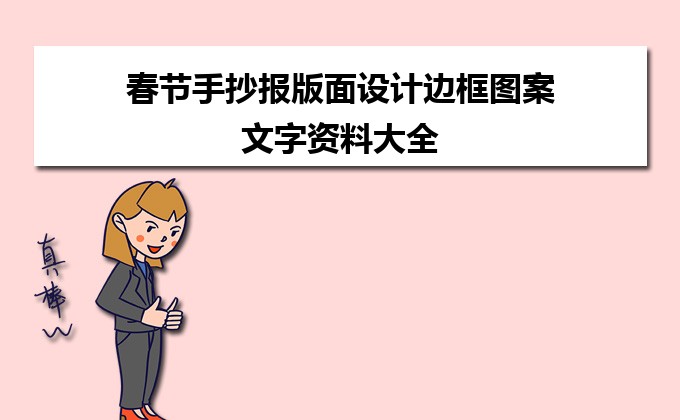2014猴年春節英語手抄報版面設計邊框圖案內容資料大全
一、春節的英文介紹中文部分
春節,是農歷正月初一,又叫陰歷年,俗稱“過年”。這是我國民間最隆重、最熱鬧的一個傳統節日。春節的歷史很悠久,它起源于殷商時期年頭歲尾的祭神祭祖活動。按照我國農歷,正月初一古稱元日、元辰、元正、元朔、元旦等,俗稱年初一,到了民國時期,改用公歷,公歷的一月一日稱為元旦,把農歷的一月一日叫春節。
春節到了,意味著春天將要來臨,萬象復蘇草木更新,新一輪播種和收獲季節又要開始。人們剛剛度過冰天雪地草木凋零的漫漫寒冬,早就盼望著春暖花開的日子,當新春到來之際,自然要充滿喜悅載歌載舞地迎接這個節日。千百年來,人們使年俗慶祝活動變得異常豐富多彩,每年從農歷臘月二十三日起到年三十,民間把這段時間叫做“迎春日”,也叫“掃塵日”,在春節前掃塵搞衛生,是我國人民素有的傳統習慣。
思而學教育閱讀配圖
然后就是家家戶戶準備年貨,節前十天左右,人們就開始忙于采購物品,年貨包括雞鴨魚肉、茶酒油醬、南北炒貨、糖餌果品,都要采買充足,還要準備一些過年時走親訪友時贈送的禮品,小孩子要添置新衣新帽,準備過年時穿。
在節前要在住宅的大門上粘貼紅紙黃字的新年寄語,也就是用紅紙寫成的春聯。屋里張貼色彩鮮艷寓意吉祥的年畫,心靈手巧的姑娘們剪出美麗的窗花貼在窗戶上,門前掛大紅燈籠或貼福字及財神、門神像等,福字還可以倒貼,路人一念福倒了,也就是福氣到了,所有這些活動都是要為節日增添足夠的喜慶氣氛。
春節的另一名稱叫過年。在過去的傳說中,年是一種為人們帶來壞運氣的想象中的動物。年一來。樹木凋蔽,百草不生;年一過,萬物生長,鮮花遍地。年如何才能過去呢?需用鞭炮轟,于是有了燃鞭炮的習俗,這其實也是烘托熱鬧場面的又一種方式。
春節是個歡樂祥和的節日,也是親人團聚的日子,離家在外的孩子在過春節時都要回家歡聚。過年的前一夜,就是舊年的臘月三十夜,也叫除夕,又叫團圓夜,在這新舊交替的時候,守歲是最重要的年俗活動之一,除夕晚上,全家老小都一起熬年守歲,歡聚酣飲,共享天倫之樂,北方地區在除夕有吃餃子的習俗,餃子的作法是先和面,和字就是合;餃子的餃和交諧音,合和交有相聚之意,又取更歲交子之意。在南方有過年吃年糕的習慣,甜甜的粘粘的年糕,象征新一年生活甜蜜蜜,步步高。待第一聲雞啼響起,或是新年的鐘聲敲過,街上鞭炮齊鳴,響聲此起彼伏,家家喜氣洋洋,新的一年開始了,男女老少都穿著節日盛裝,先給家族中的長者拜年祝壽,節中還有給兒童壓歲錢,吃團年飯,初二、三就開始走親戚看朋友,相互拜年,道賀祝福,說些恭賀新喜、恭喜發財、恭喜、過年好等話,祭祖等活動。
節日的熱烈氣氛不僅洋溢在各家各戶,也充滿各地的大街小巷,一些地方的街市上還有舞獅子,耍龍燈,演社火,游花市,逛廟會等習俗。這期間花燈滿城,游人滿街,熱鬧非凡,盛況空前,直要鬧到正月十五元宵節過后,春節才算真正結束了。
春節是漢族最重要的節日,但是滿、蒙古,瑤、壯、白、高山、赫哲、哈尼、達斡爾、侗、黎等十幾個少數民族也有過春節的習俗,只是過節的形式更有自己的民族特色,更蘊味無窮。
春節的英文介紹英文部分
Spring Festival
The Spring Festival is the most important festival for the Chinese people and is when all family members get together, just like Christmas in the West. All people living away from home go back, becoming the busiest time for transportation systems of about half a month from the Spring Festival. Airports, railway stations and long-distance bus stations are crowded with home returnees.
The Spring Festival falls on the 1st day of the 1st lunar month, often one month later than the Gregorian calendar. It originated in the Shang Dynasty (c. 1600 BC-c. 1100 BC) from the people's sacrifice to gods and ancestors at the end of an old year and the beginning of a new one.
Strictly speaking, the Spring Festival starts every year in the early days of the 12th lunar month and will last till the mid 1st lunar month of the next year. Of them, the most important days are Spring Festival Eve and the first three days. The Chinese government now stipulates people have seven days off for the Chinese Lunar New Year.
Many customs accompany the Spring Festival. Some are still followed today, but others have weakened.
On the 8th day of the 12th lunar month, many families make laba porridge, a delicious kind of porridge made with glutinous rice, millet, seeds of Job's tears, jujube berries, lotus seeds, beans, longan and gingko.
The 23rd day of the 12th lunar month is called Preliminary Eve. At this time, people offer sacrifice to the kitchen god. Now however, most families make delicious food to enjoy themselves.
After the Preliminary Eve, people begin Pparing for the coming New Year. This is called "Seeing the New Year in".
Store owners are busy then as everybody goes out to purchase necessities for the New Year. Materials not only include edible oil, rice, flour, chicken, duck, fish and meat, but also fruit, candies and kinds of nuts. What's more, various decorations, new clothes and shoes for the children as well as gifts for the elderly, friends and relatives, are all on the list of purchasing.
Before the New Year comes, the people completely clean the indoors and outdoors of their homes as well as their clothes, bedclothes and all their utensils.
Then people begin decorating their clean rooms featuring an atmosphere of rejoicing and festivity. All the door panels will be pasted with Spring Festival couplets, highlighting Chinese calligraphy with black characters on red paper. The content varies from house owners' wishes for a bright future to good luck for the New Year. Also, pictures of the god of doors and wealth will be posted on front doors to ward off evil spirits and welcome peace and abundance.
The Chinese character "fu" (meaning blessing or happiness) is a must. The character put on paper can be pasted normally or upside down, for in Chinese the "reversed fu" is homophonic with "fu comes", both being pronounced as "fudaole." What's more, two big red lanterns can be raised on both sides of the front door. Red paper-cuttings can be seen on window glass and brightly colored New Year paintings with auspicious meanings may be put on the wall.
People attach great importance to Spring Festival Eve. At that time, all family members eat dinner together. The meal is more luxurious than usual. Dishes such as chicken, fish and bean curd cannot be excluded, for in Chinese, their pronunciations, respectively "ji", "yu" and "doufu," mean auspiciousness, abundance and richness. After the dinner, the whole family will sit together, chatting and watching TV. In recent years, the Spring Festival party broadcast on China Central Television Station (CCTV) is essential entertainment for the Chinese both at home and abroad. According to custom, each family will stay up to see the New Year in.
Waking up on New Year, everybody dresses up. First they extend greetings to their parents. Then each child will get money as a New Year gift, wrapped up in red paper. People in northern China will eat jiaozi, or dumplings, for breakfast, as they think "jiaozi" in sound means "bidding farewell to the old and ushering in the new". Also, the shape of the dumpling is like gold ingot from ancient China. So people eat them and wish for money and treasure.
Southern Chinese eat niangao (New Year cake made of glutinous rice flour) on this occasion, because as a homophone, niangao means "higher and higher, one year after another." The first five days after the Spring Festival are a good time for relatives, friends, and classmates as well as colleagues to exchange greetings, gifts and chat leisurely.
Burning fireworks was once the most typical custom on the Spring Festival. People thought the spluttering sound could help drive away evil spirits. However, such an activity was completely or partially forbidden in big cities once the government took security, noise and pollution factors into consideration. As a replacement, some buy tapes with firecracker sounds to listen to, some break little balloons to get the sound too, while others buy firecracker handicrafts to hang in the living room.
The lively atmosphere not only fills every household, but permeates to streets and lanes. A series of activities such as lion dancing, dragon lantern dancing, lantern festivals and temple fairs will be held for days. The Spring Festival then comes to an end when the Lantern Festival is finished.
China has 56 ethnic groups. Minorities celebrate their Spring Festival almost the same day as the Han people, and they have different customs.
二、the Origin of Chinese New Year
中國春節的由來
the Chinese New Year is now popularly known as the Spring Festival because it starts from the Begining of Spring (the first of the twenty-four terms in coodination with the changes of Nature). Its origin is too old to be traced. Several explanations are hanging around. All aGREe, however, that the word Nian, which in modern Chinese solely means "year", was originally the name of a monster beast that started to Py on people the night before the beginning of a new year.
One legend goes that the beast Nian had a very big mouth that would swallow a GREat many people with one bite. People were very scared. One day, an old man came to their rescue, offering to subdue Nian. To Nian he said, "I hear say that you are very capable, but can you swallow the other beasts of Py on earth instead of people who are by no means of your worthy opponents?" So, it did swallow many of the beasts of Py on earth that also harrassed people and their domestic animals from time to time.
After that, the old man disappeared riding the beast Nian. He turned out to be an immortal god. Now that Nian is gone and other beasts of Py are also scared into forests, people begin to enjoy their peaceful life. Before the old man left, he had told people to put up red paper decorations on their windows and doors at each year's end to scare away Nian in case it sneaked back again, because red is the color the beast feared the most.
From then on, the tradition of observing the conquest of Nian is carried on from generation to generation. The term "Guo Nian", which may mean "Survive the Nian" becomes today "Celebrate the (New) Year" as the word "guo" in Chinese having both the meaning of "pass-over" and "observe". The custom of putting up red paper and firing fire-crackers to scare away Nian should it have a chance to run loose is still around. However, people today have long forgotten why they are doing all this, except that they feel the color and the sound add to the excitement of the celebration.









